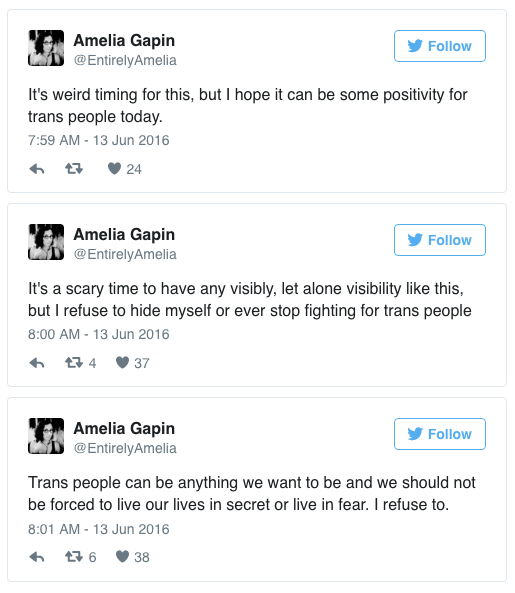This Magazine Cover Will Go Down in History

By:
Trans woman and marathon runner Amelia Gapin just made history.
Gapin is the first transgender person to be featured on the cover of a U.S. fitness magazine.
She explained that running helped her with her body image after her transition.
She told ATTN:
"When it comes to body image post-transition, it's really, really hard. I would be lying if I said I didn't still struggle with that. I think we all have our own particular aspects of body image that we struggle with, but running has helped me a lot with it. It helps me keep some of the weight off and it allows me to focus on the idea of having a more athletic body rather than one that is more "traditionally" feminine and dainty in appearance. But still, it's often a conscious effort to see the femininity in my body."
Gapin told PEOPLE that the cover gave her a sense of validation.
During a time of personal celebration, Gapin also emphasized how her victory could be a source of solace to the LGBTQ community in the wake of the Orlando shooting.
 twitter.com
twitter.com
Gapin co-founded MyTransHealth.com, which she says strives "to ensure that all trans and gender nonconforming people receive culturally competent service." She also uses her Instagram account as a forum to show her progress and to establish herself as an example for the growing transgender fitness community.
Gapin opened up about the challenges and safety concerns she faces.
"I also deal with the same safety concerns and thoughts around that as any other woman does while out for a run. I get catcalled, I've been followed. But I also have the added concern that if someone were to try to attack me, what happens when they find out I'm transgender? Does a potential rape turn into murder too? Rape is terrifying enough on its own, but the additional threat of how someone may react when finding out you're trans really intensifies those fears."
As the first transgender person to appear on a U.S. fitness magazine cover (Europe had its first in the German edition of Men's Health), Gapin calls attention to the silenced uphill battle many trans people face.
"As a trans athlete, it's not much different from being a trans person in general, there's a big question about disclosure. Should I disclose being trans for races? How should I register for races? All of my ID says female, but up until having surgery, I was technically supposed to register as male for races according to [USA Track & Field] rules. Does it really even matter if I'm not winning or placing? The moment I started presenting myself to the world as Amelia, I refused to register as male. I had been on hormones for a while at that point and had already more than a half hour off my marathon time so I didn't feel like I had any sort of advantage."
Looking forward, Gapin took a moment to reflect on the significance of her debut on the cover as as way to empower the LGBTQ community.
"For me, being on the cover is about putting positivity into the world for trans people and showing what's possible," she said. "You can be trans and still be anything else you want to be. I also hope that it can help cisgender people see us as the women and men that we are and treat us with dignity and respect."
